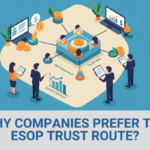The ESOP trust route is a strategic tool for employers to retain top talent and align with long-term goals, but poor design can lead to financial strain, inequity, and talent loss. Whereas for employees, unclear or unfair structures can cause dissatisfaction and disengagement.
A balanced approach with reverse vesting clauses, hybrid schedules, and clear ESOP tiers ensures fairness, inclusivity, and mutual growth, being a dual perspective creates a win-win scenario, ensuring the ESOP trust route drives both organizational growth and employee satisfaction.
Retention Challenges:
An IT services firm faced a sudden rise in attrition rates, particularly among mid-level managers and top-performing employees. Despite offering ESOPs as part of their compensation package, the company encountered the following challenges:
Issues Faced
- Management Attrition Before Full Vesting:
- Chief Officers and Senior managers were leaving before completing their vesting schedules, leading to a loss of talent and unvested equity.
- Misalignment of Performance Expectations:
- Some employees failed to meet performance benchmarks, resulting in dissatisfaction with their vesting outcomes.
- Ensuring Fairness in ESOP Allocations to Avoid Resentment:
- Employees in similar roles felt inequity in ESOP allocations, leading to resentment among non-ESOP employees.
- Inadequate Retention Mechanisms:
- Lack of safeguards like reverse vesting or hybrid vesting left the company vulnerable to high turnover.
Practical Solutions Implemented
- Reverse Vesting Clauses
To safeguard company interests, an IT services firm introduced reverse vesting clauses, ensuring that unvested or partially vested shares were protected when employees left prematurely.
- Unvested Shares Forfeiture: Employees leaving the company before completing their vesting period forfeited unvested shares automatically.
- Partially Vested Shares Buyback: The company retained the right to buy back partially vested shares at FMV, minimizing disruptions caused by employee exits.
- Performance Clawbacks: Employees failing to meet performance targets saw a proportionate reduction in their vested shares.
Outcome: These clauses deterred employees from leaving prematurely and ensured the company retained control over unvested equity.
- Hybrid Vesting
To balance long-term retention and employee motivation, a hybrid vesting schedule was introduced. The vesting combined time-based and performance-based criteria:
- Time-Based Component:
- 50% of ESOPs vested over a three-year period to reward tenure.
- Performance-Based Component:
- 50% of ESOPs vested annually based on KRAs (e.g., revenue targets, operational efficiency metrics).
Outcome: This model rewarded loyalty while incentivizing high performance, aligning employee goals with company success.
- Second ESOP Grant Plan
Employees nearing the end of their vesting period were provided with a second ESOP grant plan to keep them invested in the company’s long-term goals.
- Criteria:
- Employees who demonstrated high performance or occupied key roles received additional ESOP grants.
- Outcome: This reduced attrition among senior employees, ensuring continuity in leadership roles.
- Incentivizing Employees Through Profit-Sharing Programs
To retain the management and motivate them, an IT services firm introduced a profit-sharing program:
- Mechanism:
- Cash bonuses were linked to individual and team KRAs, ensuring alignment with company goals.
- Outcome: This created a sense of fairness and motivated employees who couldn’t get the ESOPs as for not achieving the targeted goals.
- Leadership Perks and Second-Line Development
To retain top management and create a succession pipeline, the company introduced:
- Leadership Perks: Stock options with accelerated vesting, cash bonuses, and personalized rewards for senior leaders.
- Second-Line Development: Training programs to groom mid-level managers for leadership roles, incentivized with performance-linked rewards.
Outcome: This reduced the burden on existing leaders and created a robust succession plan, mitigating risks associated with key personnel exits.
- Clear ESOP Tiers and Non-Equity Rewards
The company restructured its ESOP allocations and complemented them with non-equity rewards:
- Defining Clear Tiers:
- ESOPs were segmented by roles and contributions (e.g., CEO, senior managers, mid-level employees).
- Non-Equity Rewards:
- Non-ESOP employees received bonuses, promotions, and performance-based incentives to ensure fairness.
Outcome: This structure minimized resentment and fostered a sense of inclusion across the organization.
Conclusion
Retention challenges, especially in competitive markets, require a multi-faceted approach that combines reverse vesting, hybrid schedules, and performance-linked rewards. If you intend to adopt such strategies, that strike the right balance between retaining talent and achieving long-term growth, let’s connect on Mail id: info@sncoglobal.com





